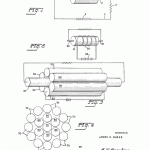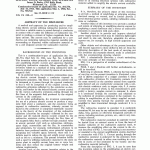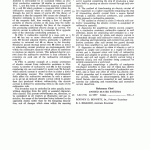Inventors: James O. Burke, James O. Burke
Current U.S. Classification: 310/301
Patent number: 3530316
Filing date: Mar 1, 1968
Issue date: Sep 22, 1970
ABSTRACT OF THE DISCLOSURE
A method and apparatus for producing and/or amplifying electric current utilizing radioactive material. Current from a suitable source is passed through a conductor in contact with or under the influence of radioactive material to produce a current of higher magnitude than the input current. The current may be conducted by a conductive can containing radioactive material, metallic rods surrounding or dispersed within radioactive material or by a coil disposed around the radioactive material.
SUMMARY OF THE INVENTION
It is, therefore, the primary object of this invention to provide a method of amplifying or enlarging existing electrical energy or current, and to further provide a novel electrical power system, utilizing radioactive emissions or radiations.
Another object of this invention is to provide a method and system of enlarging or amplifying electric current by employing a metal conductor and a source of radioactive emissions in association with each other. Another object is to provide and improve electrical power supply systems which may be relatively lightweight and small in size and, therefore, adaptable for advantageous use, for example, in high altitude apparatus and craft.
Other objects and advantages of the present invention will become apparent to those skilled in this art from the following description of the best mode of carrying out this invention and examples thereof, made in connection with the accompanying drawing wherein:
FIG. 1 schematically illustrates a circuit embodying the basic principle of this invention;
FIG. 2 is a perspective of another embodiment of the invention;
FIGS. 3 and 4 illustrate still further embodiments, as will be described.
Referring to schematic FIGS. 1, wherein the best mode of carrying out the present invention is illustrated, a circuit is shown comprised of a copper cannister 1 filled with radioactive strontium 90. Conductive contacts 2 of the same material as the cannister extend from opposite ends thereof and are conductively connected with a suitable electric conductor such as copper wire 3. A source of electrical energy 4 which, in this embodiment is preferably a battery, supplies current to cannister 1, where it is conducted through the cannister and subjected to the radiation of strontium contained in the cannister, resulting in amplification of the battery supplied current.
Current thus passing through the cannister and being amplified is then transmitted through conductor 3 to a load 5.
The radioactive material in cannister 1 is preferably strontium 90, but may be any radioactive emitter, emitting alpha, beta, gamma or otherwise designated particles or waves, including neutrons, protons, etc., and/or any combination thereof.
The radioactive material contained in cannister 1 may be heated from an external source or from the heat of nuclear radiation of the radioactive material itself, to increase the amplifying effect on the current in the circuit described in FIG. 1, but such heating is not necessary or essential to the current amplification system described in connection with FIG. 1. Current passing through the conductive cannister is enhanced by the emissions from the radioactive material in either case resulting in a current in excess of that produced by the battery and the radioactive material indirectly.
From the description of FIG. 1, it can be seen that this invention relates to the amplification of electric current by the emission of radioactive material through or about which current is caused to flow, and also the enhancement of electric discharge by causing an electric current to flow through the radioactive material. There are many possible physical arrangements whereby an electric current can be made to pass through a radioactive material, and broadly speaking, the present invention is intended to encompass any such invention in which … Click images below to continue reading












